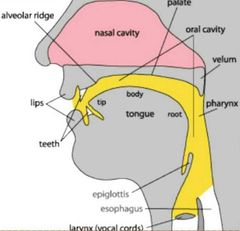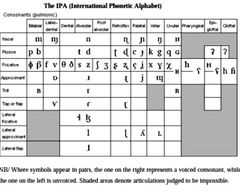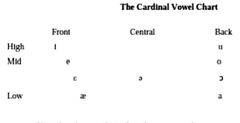![]()
![]()
![]()
Use LEFT and RIGHT arrow keys to navigate between flashcards;
Use UP and DOWN arrow keys to flip the card;
H to show hint;
A reads text to speech;
26 Cards in this Set
- Front
- Back
- 3rd side (hint)
|
Linguistics101 |
Linguistics |
Scientific study of language and its structure.it involves the analysis of language meaning,and language in context. |
|
|
Phonetics |
Is a branch of linguistics that studies how humans make and perceive sounds in all languages. |
|
|
|
Phonology |
Is a branch of linguistics which studies how languages group sounds together.it is primarily concerned with the systematic organization of sounds in spoken languages . |
|
|
|
Levels of sounds representation1 |
Acoustic phonetics:concerned with the study of the physical properties of the sounds themselves and how sounds are affected while traveling through the air. |
|
|
|
L o s r 2 |
Articulatory phonetics : concerned with the study and description of how speech sounds are produced . |
|
|
|
L O S R 3 |
Auditory phonetics: concerned with the way the speech sounds are perceived |
|
|
|
Organs of speech |
The anatomical components of the speech system for human language comprise the subglottal system: lungs , the diaphragm and the treacha |
When the air is pressed out to the lungs, it travels up the treacha ,or the windpipe to the larynx which contains folds of muscles called the vocal folds . This folds can be relaxed ,letting the air flow freely through the glottis or tensed ,so that the air vibrates as it passes through the glottis. |
|
|
Above the larynx |
It contains three main areas: pharynx,the nasal cavity and the oral cavity. |

|
|
|
Airstream mechanism |
It is the means to initiation (by which the air - flow is created)along with articulation .they are mandatory of sound production. |
There are two directions of airflow : egressive : outward air flow///ingressive:inward air flow. |
|
|
There are three initiators: lungs, glottis, tongue. |
Pulmonic: where the air is pushed out of the lungs by the ribs and the diaphragm // Glottalic: it is possible to initiate an air - flow in the respiratory fract by means of the vocal cords or the glottis.// Velaric or lingual: the initiator here is the tongue , the air in the mouth is rarefied by a downward movement of the tongue ; Velaric stops (clicks) |
|
|
|
Voiceless and voiced sounds |
The airstream from the lungs moves up through the treacha ,or windpipe and through the opening between the vocal cords which is called the glottis |
If the vocal cords are apart the airstream is not obstructed at the glottis and it passes freely into the superglottal cavities.the sounds produced in this way are called voiceless sounds (P T K S ) if the vocal cords are together and the airstream forces its way through and causes them to vibrate ,such sounds are called voiced sounds (B D G Z ) |
|
|
Nasal 🆚 oral sounds |
The airstream can exit the pharynx in two ways;depending on the position of the uvular: |
■if the uvular is lowered ;the air will pass through the nasal cavity ■if the uvular is raised:the air will pass through the oral cavity |
|
|
Articulatory modification of sounds:Consonants and vowels |
Consonants: in order to form consonants , the airstream through the vocal tract must be obstructed in some way; consonants can therfore be classified according to the place and manner of this obstruction: place of articulation : ▪bilabial: sounds produced by bringing both lips together as in B P / ▪labiodentals: sounds produced by raising the lower lip and pressing it against the front teeth as in F V / ▪dentals: sounds produced by raising the tip of the tongue or blade and placing it against the upper front teeth as in (the)/ ▪alveolars: sounds produced by raising the tip or blade and placing it against the alveolar ridge as in T S D Z /▪PALATALS: produced with the front of the tongue and the hard palate as in j / ▪velars: sounds produced by raising the back of the tongue to the soft palate as in K G /▪Uvulars: they are consonants articulated with the back of the tongue against or near the uvula, that is; further back in the mouth than velar consonants. q is voiceless uvular stop / ▪pharyngeals: sounds articulated with the tongue retracting into the pharynx such as ? ع |
|
|
|
Manners of articulation :the way the articulator places the articulation ;completely close off the oral tract for an instant or a relatively long period ; they may narrow the space considerably; or they may simply modify the shape of the tract by approaching ech other. |
stops: a complete closure of the erticulators involved so that the airstream cannot escape through the mouth.there are two possible ways of stops: nasal stops: if the air is stopped in the oral cavity but uvular is down so that it can go out through the nose , he sound produced is a nasal stop as in m n ;; oral stops: if in addition to the articulatory closure in the mouth , the uvular is raised so that the nasal tract is blocked off , the airstream will be completely obstructed . Pressure in the mouth will build up an oral stop will be formed.when the articulator come apart the airstream will be released in a small burst of sound as in p b t d k g / Fricatives: the is a close approximation of two articulator so that the airstream is partially obstructed and a turbulent airflow is produced , as illustrated by the sounds f v s S:(sh) ,and the voiced velar Fricative symbolized as ¥ and it's voiceless counterpart x/Affricates: these are sounds produced by a stop closure followed immediately by a slow release of the closure characteristic of a Fricative dg and tS are such sounds./Silibants: these are sounds produced with a hissing noise. The Fricatives and the Affricates represent this class . /Obstruents: the non nasal stops; the Fricatives and the Affricates form a Class of sounds which can be distinguished from all other sounds. Obstruents contrast with Sonorants, which have no such obstruction and so resonant.All Obstruents are consonants,but sonorants include both vowels and consonants . |
All other sounds are called continuants because the stream of air continues without interruption through the mouth opening. |
|
|
Some other sounds |
Do not easily fall into these two classes ( consonants and vowels) |
Glides: such as j and w , for example, are like vowels in that they are produced with little or no obstruction of the airstream in the mouth ; but they are also like consonants in the their duration is very short.when occurring in a word ,they must always be either preceded or followed directly by a vowel .Liquids: l and r are like consonants in some ways and vowels in others. Because they are produced with obstructions in the oral cavity they are like consonants, but acoustically they have resonant like vowels |
|
|
IPA |

|
|
|
|
Vowel classification |
☆in terms of height ☆in terms of position of the tongue ☆in terms of lip rounding |

|
|
|
Unrounded front and back vowels |
Front vowels are never rounded in english ,this is not true in all languages . French has both rounded and unrounded front vowels and back rounded vowels. |
Y as in tu Ø as in blue Œ as in heure |
|
|
Nasal and mazalized vowels |
Vowels that are produced with a lowered uvular permitting air to escape through the nose,called nasalized |
To specify that a vowel is nasalized ,the Diacritic ~ mark is placed over the vowel as in : bomb [bām] ; an [ā] ; son [sõ] "sound" |
|
|
Secondary articulation : there are a number of secondary articulation implemented by the position of the body of the tongue. |
▪palatalization: it involves raising of the body of the tongue to a high position that approximates the point it assumes in the articulation of the the vowel i, this tongue position can then be superimposed on the pimary articulation of a labial, dental, alveolar, and alveopalatal consonant.EX: brat = brother ; brat'y =to take ▪Velarization: the body of the tongue can assume a high back attitude ,creating the possibility. In english the "clear" l of 'leaf' is phonetically opposed to the "dark" (velarized) l* of "feel". ▪Pharyngealizarion: the so-called emphatic consonants of the semitic languages like Arabic involve the secondary articulation ,in which the root of the tongue is retracted toward the back of the pharynx . Şi:f [summer] si:f [sword]. |
|
|
|
Phonology |
The study of the systematic pattering and organization of speech sounds in a language.Its task,as trubezoky puts it《it is the task of phonology to study which differences in sound are related to differences in meaning In a given language》. |
How sounds are produced and what their physical properties are. |
|
|
Redundancy and distinctiveness |
Redundancy:predictable; aspiration can be predictable in some languages causing no Change in meaning as in english: Phple ppl Distinctiveness:not predictable; capable of changing meaning Phonology is concerned with how sounds function in different languages. ▪phonemes are capable of distinguishing words of different meanings. ▪(contextual variants or allophones) are predictable from given environment. |
|
|
|
Levels of sound representation |
▪There are two ways to represent a sound: phonetic description ([...]) or phonological description (/.../) ([surface,narrow ,concrete ;PhIN]);; (/deep,broad,abstract, mental;PIN/) -In German , ch can be pronounced either [x]=خ or [ç]=كي [X]:when preceded by a back vowel [Ç]: when preceded by a front vowel ,a consonant,or Ø >they are predicted from given context ,these 2 sounds are derived from the same unit or the phonological level.That is ,from the same phoneme. |
|
|
|
Phonological Rules |
Specify how words and combinations of words are pronounced. |
|
|
|
How can we determine the underlying phoneme? |
▪Distribution: (context):The underlying phoneme is usually the sound which occurs in the elsewhere environment[in the most diverse set of environment ]most diverse is the basic. ▪Phonetic plausibility : related to the process of assimilation ▪Universal Tendency: some sounds can be found more than others : d--dj t---tch |
|
|
|
Phonological Rules: |
Formal statements ,using distinctive features of a phonological alternation, in the forms "A becomes B in the context of C " ▪Phonological Rules convert phonological representations into a phonetic ones. ▪The different kinds of operations that phonological Rules can perfome: 1 - phonological Rules can delete segment: /fənع:tr/ is converted to [fnع:tr].This can be schematized as follows : ə--ø/vc #this is optional because the speaker can pronounce either ə/ø 2 - phonological Rules can insert segments: •Spanish inserts [ع] before word initial ø- ع /##.... sC 3 - phonological Rules can change segments and pronounce alternations: Miss---Mish /please---plidg/bet--betsh/fed---fedg ==>To reveal that these two classes of segments are not composed of random members,the rule by which the former consonants are converted into the latter consonants before /Y/ should:as a first approximation be written as follows: Alveolar---Alveopalatal /......Y |
|

